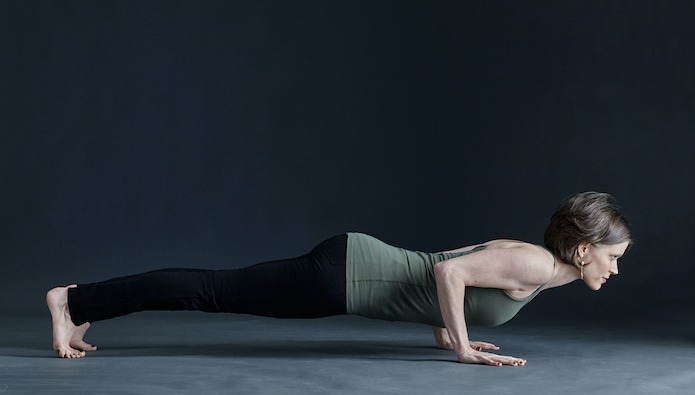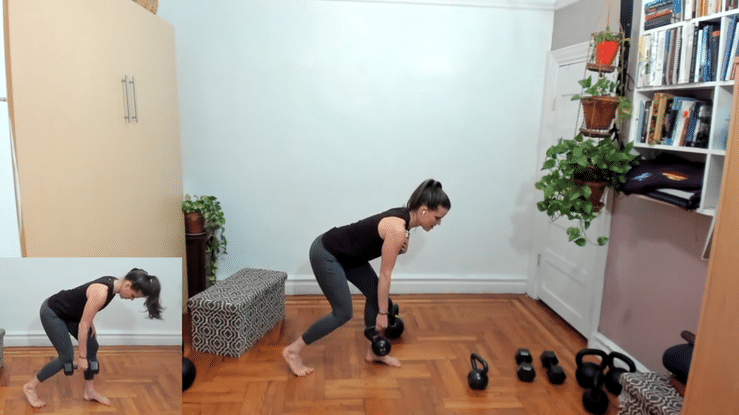Look in any of the traditional yoga asana books, including the Yoga Teacher Training manuals I taught from for years, and you’ll see a whole lot of drawings and/or photographs of the poses the typical modern yoga class comprises. Below the image you might see a lot of words laying out all the alignment points for that pose—the things you should be doing to do the pose “safely” or “right.”

For me, and many of my student-teachers, Chaturanga was one of those poses I went back to the books on over and over.
The reason I drilled those alignment cues into our brains was simple: something about the pose wasn’t working in my or my students’ bodies.
Throughout my 12 years of teaching, I was asked countless times to check out someone’s alignment to help them with the sharp, nagging pain at the front of their shoulder.
This push-up position, one of the bread and butter poses of modern postural yoga, was to blame.
As a former self-described “alignment-based teacher” and anatomy junkie, part of me loved these questions. (I didn’t love that people were in pain, though.)
“Well there are a couple of things we can look at,” I’d say. Then I’d run off a litany of alignment concepts that I loved learning about, and thought could be useful, such as:
- scapulohumeroclavicular rhythm—how the different joints in the shoulders and arms and chest work together when you move
- scapular tilt—aka “winging,” where your shoulder blades spread to the side like little chicken wings
- eccentric contraction of the triceps, serratus anterior, anterior deltoids— “eccentric” because the muscle fibers don’t lengthen when they contract (like woah)
- joint angles—usually 90 degree ones work best because then bones will stack, but not many people get there in the pose!
- How different people needed to shift forward more or less before lowering depending on their body proportions (no one size fits all asana)
- and on and on…

The student would thank me, go on their merry way, then BOOM I’d get asked again. The same darn question. The same shoulder pain. The same pose.
After a while, even I got a little tired of this spiel. I started to think something was up. It’s not that I needed to be right in my suggestions, but I wanted a better answer.
Since alignment wasn’t doing it for me, I widened my field of inquiry.
Deeper conversation about students’ practices often revealed that yoga was the main course on their movement menu. This raised a red flag for me. Yoga asana does lots of things, but one thing it doesn’t do particularly well is offer a whole lot of opportunities to practice pulling—you know, like holding onto something (maybe it’s heavy-ish) and bringing it toward your body. Chaturanga (along with downward facing dog, plank pose, upward facing dog, handstands, and more) is all about pushing.
Knowing how to push well is important, but when you only push the muscles and joints that do that movement get all the attention, while the pulling parts are left in the back of the room with the worn-out straps and lost yoga mats. I imagine these important muscles of your shoulder start to feel left out, and might start crying out for attention in the form of pain.
Throwing alignment at this problem won’t make the pain go away, because it’s more about how you’re loading these parts of your body, and less about where they are in relation to one another.
(By the way, the diversity of movement is important beyond pushing/pulling. In the sports world we call it “cross training”—where a basketball player knows they have to do more than play basketball to be good at basketball.)

Now, before you get in a tizzy thinking alignment is fake news, consider this: We can still practice “alignment,” i.e., the shape of chaturanga (or any pose), while we alter the experience of load on our tissues. Yep, we can keep alignment and all those cool facts about how our bodies move, but make them more interesting by shifting how we feel in those positions.
We can’t alter the rules of the universe and start pulling the floor to us when we’re in traditional Chaturanga. But in this video I made for my course Resistance Bands 101 with Yoga Journal, I share a cool Chaturanga variation with a resistance band. Same shoulder alignment, different shoulder load! Try it and let me know what you think.


Leave a Reply